Comparative Evaluation of Aluminum Sulfate and Ferric Sulfate-Induced Coagulations as Pretreatment of Microfiltration for Treatment of Surface Water
Abstract
:1. Introduction
2. Experimental Methods
2.1. Reagents and Materials
| Material | Polyvinylidene fluoride (PVDF) |
|---|---|
| Type | Hollow fiber |
| Pore size, μm | 0.1 |
| Membrane surface area, cm2 | 75 |
| Type of filtration | Dead-end |
| Type of pressure | Outside-inside |
2.2. Coagulation Pretreatment
2.3. Experimental Apparatus
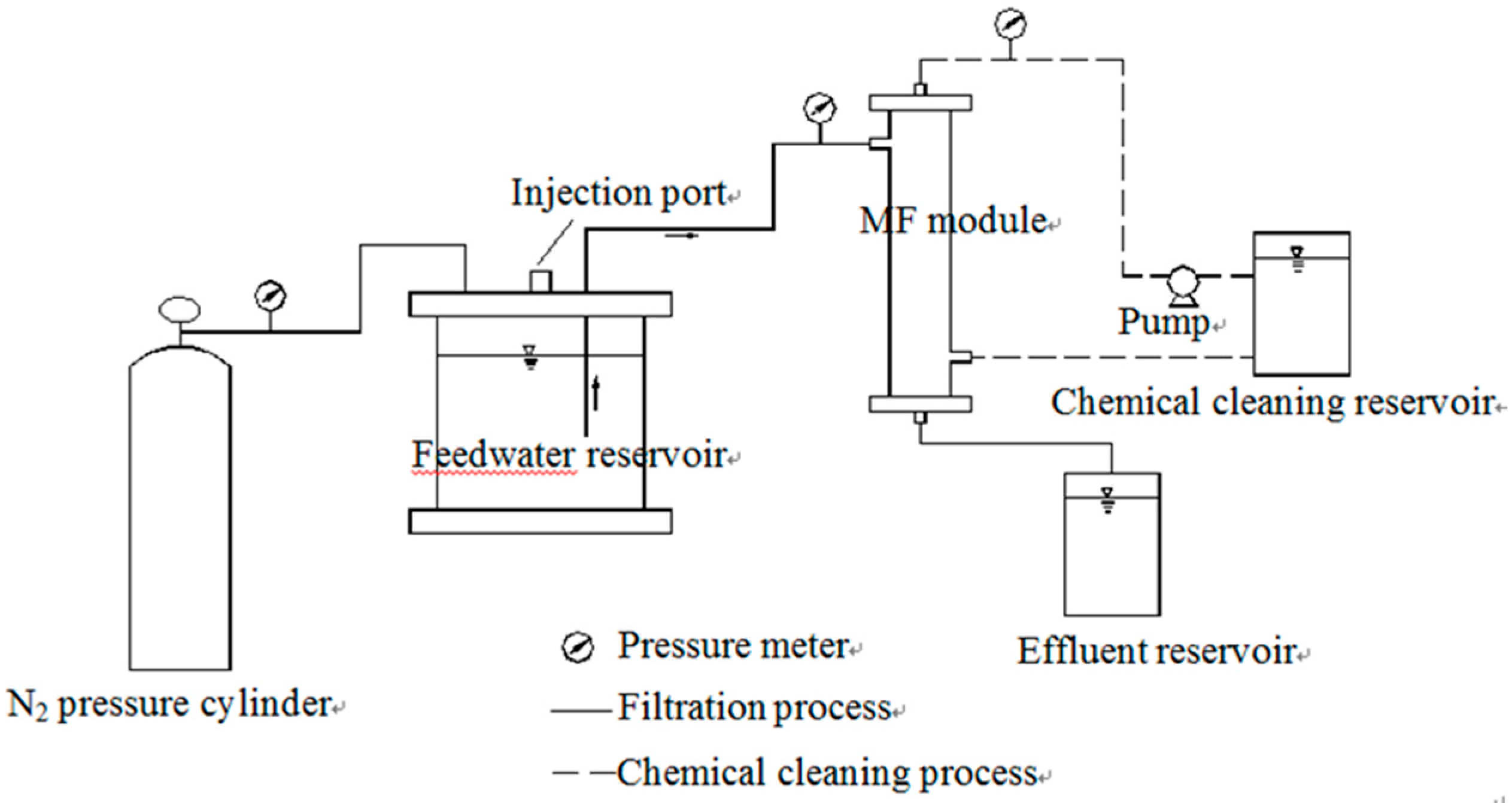
2.4. Analysis
3. Results and Discussion
3.1. Molecular Weight Distribution of Dissolved Organic Matter (DOM)
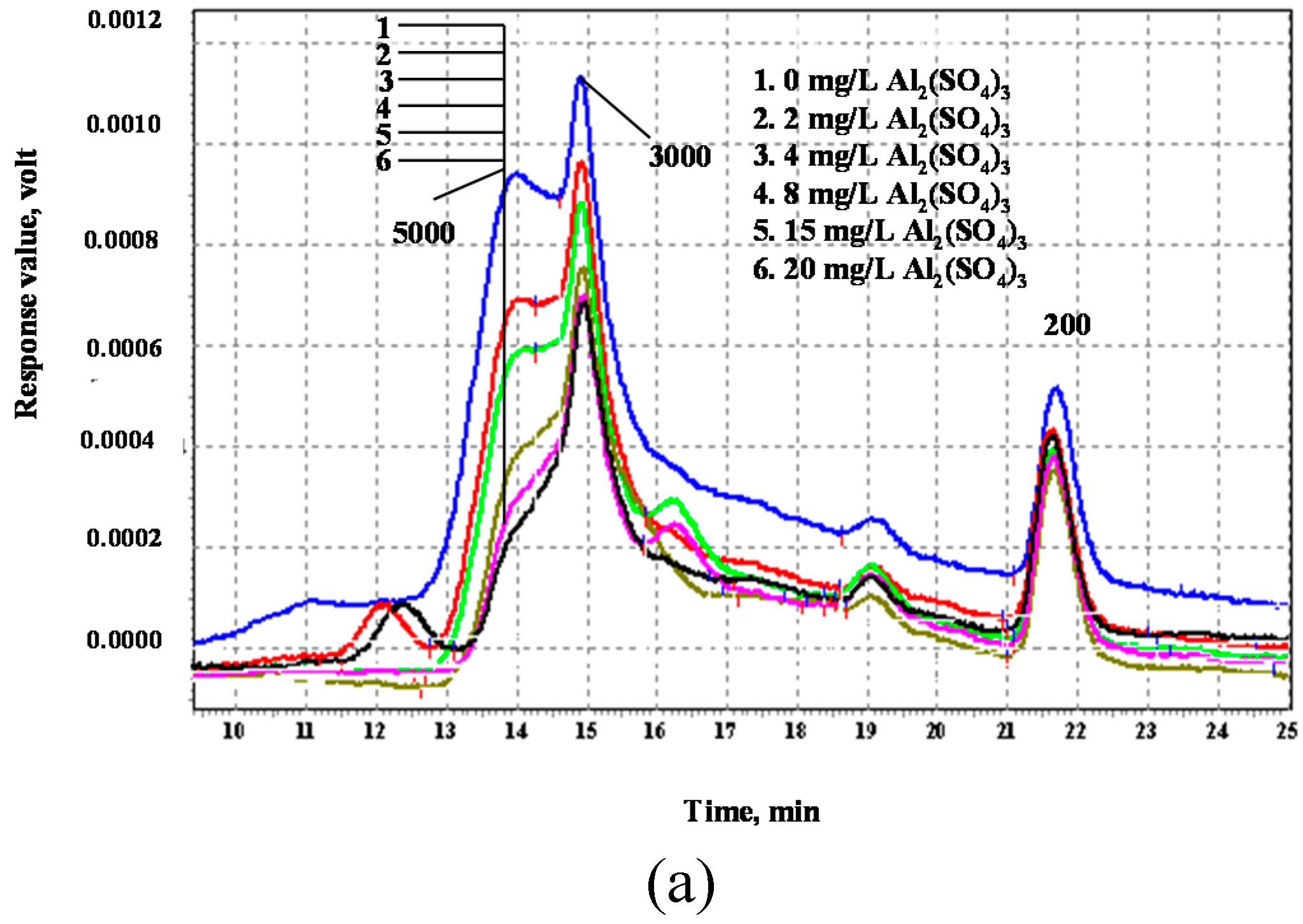
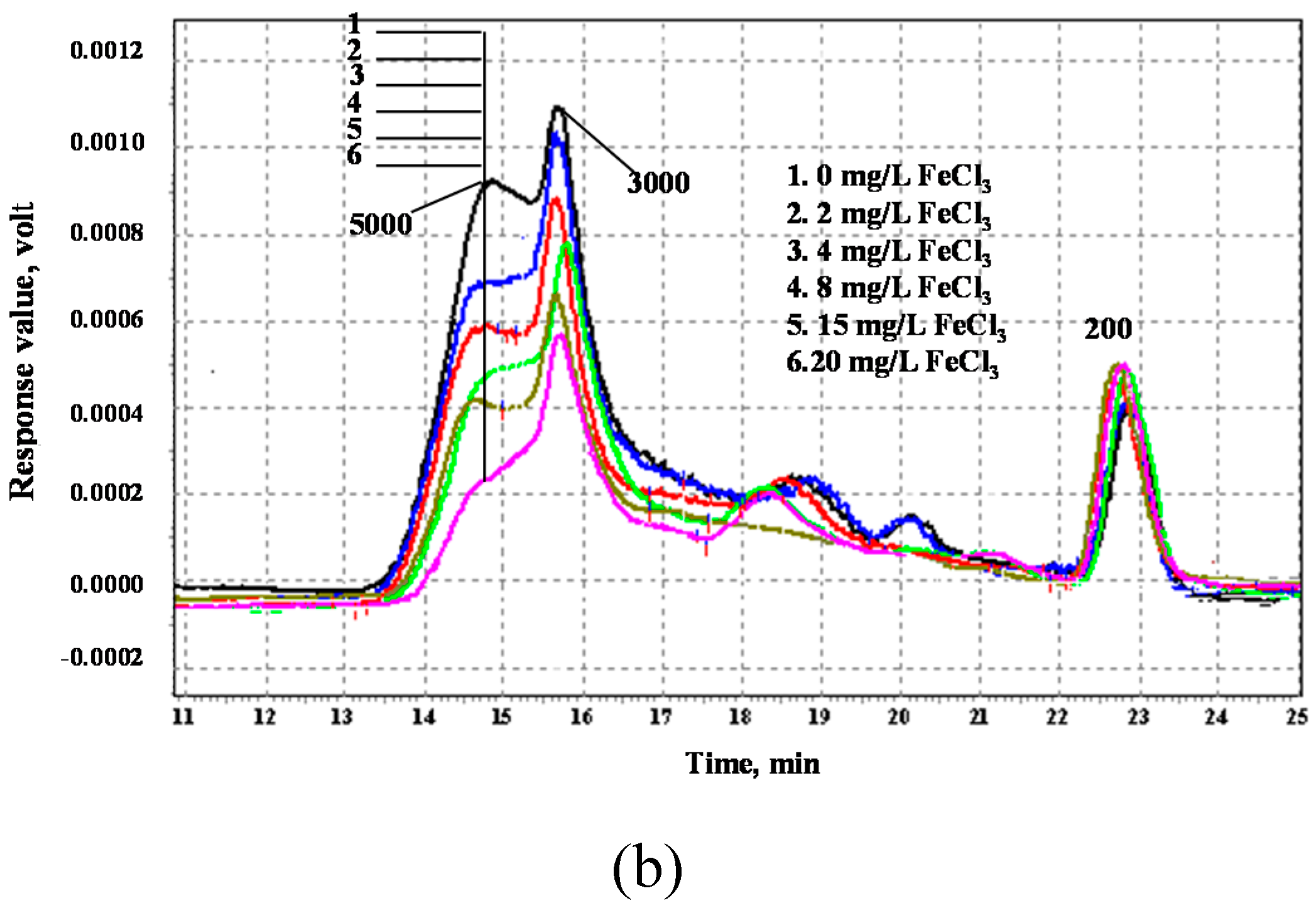
3.2. DOC and UV254
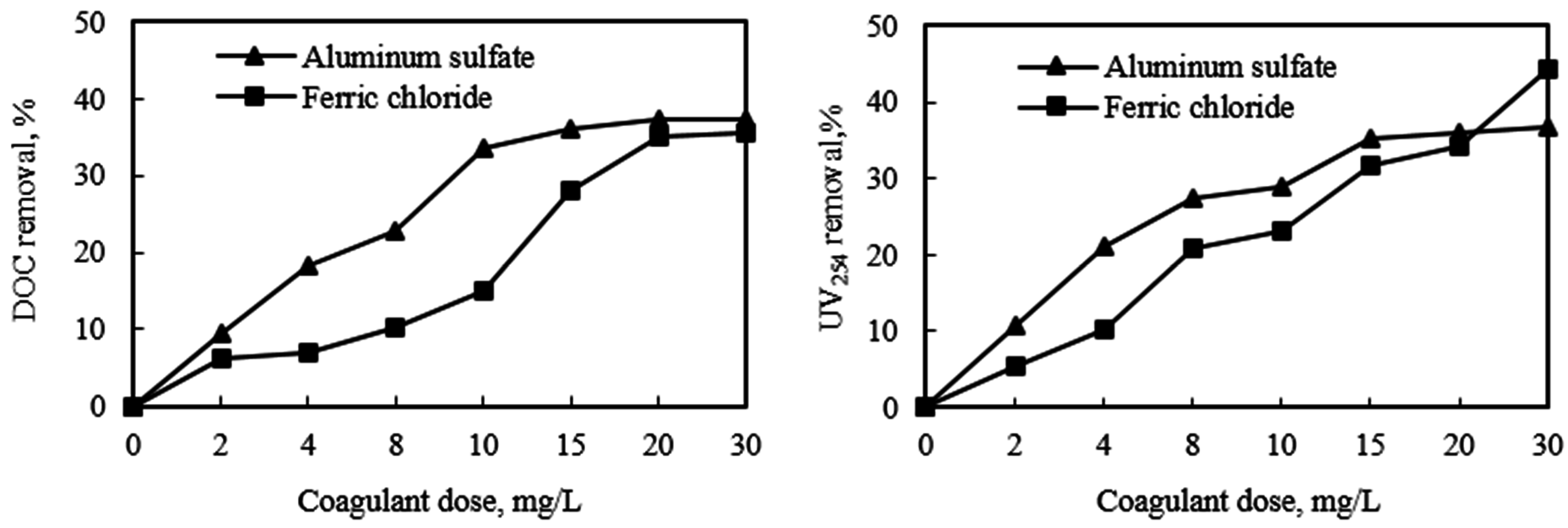
3.3. Membrane Flux
- Φ—membrane fouling decline rate, %
- JR—final membrane flux of raw water, %
- JC—final membrane flux of coagulation treatment, %

3.4. Discussion
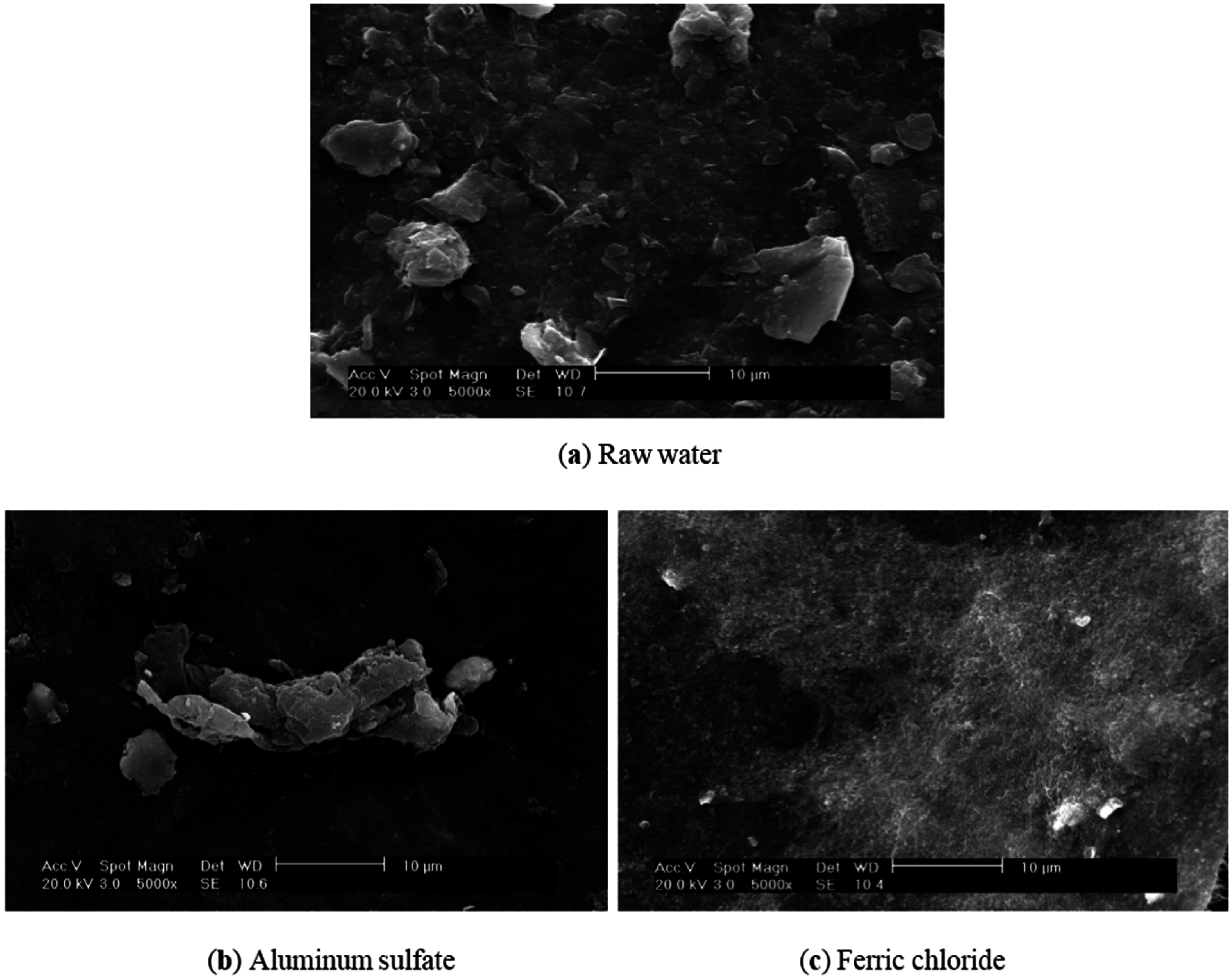
4. Conclusions
Acknowledgments
Author Contributions
Conflict of Interest
References
- Takizawa, S.; Fujita, K.; Soo, K.H. Membrane fouling decrease by microfiltration with ozone scrubbing. Desalination 1996, 106, 423–426. [Google Scholar] [CrossRef]
- Sakol, D.; Konieczny, K. Application of coagulation and conventional filtration in raw water pretreatment before microfiltration membranes. Desalination 2004, 162, 61–73. [Google Scholar] [CrossRef]
- Park, P.-K.; Lee, C.-H.; Choib, S.-J.; Choo, K.-H.; Kimd, S.-H.; Yoone, C.-H. Effect of the removal of DOMs on the performance of a coagulation-UF membrane system production. Desalination 2002, 145, 237–245. [Google Scholar] [CrossRef]
- Konieczny, K.; Klomfas, G. Using activated carbon to improve natural water treatment by porous membranes. Desalination 2002, 147, 109–116. [Google Scholar] [CrossRef]
- Taniguchi, M.; Kilduff, J.E.; Belfort, G. Modes of natural organic matter fouling during ultrafiltration. Environ. Sci. Technol. 2003, 37, 1676–1683. [Google Scholar] [CrossRef] [PubMed]
- Huang, H.; Spinette, R.; O’Melia, C.H. Direct-flow microfiltration of aquasols I. Impacts of particle stabilities and size. J. Memb. Sci. 2008, 314, 90–100. [Google Scholar] [CrossRef]
- Kabsch-Korbutowicz, M. Application of ultrafiltration integrated with coagulation for improved NOM removal. Desalination 2005, 174, 13–22. [Google Scholar] [CrossRef]
- Cho, M.-H.; Lee, C.-H.; Lee, S. Effect of flocculation conditions on membrane permeability in coagulation–microfiltration. Desalination 2006, 191, 386–396. [Google Scholar] [CrossRef]
- Konieczny, K.; Sąkol, D.; Bodzek, M. Efficiency of the hybrid coagulation–ultrafiltration water treatment process with the use of immersed hollow-fiber membranes. Desalination 2006, 198, 102–110. [Google Scholar] [CrossRef]
- Konieczny, K.; Bodzek, M.; Rajca, M. A coagulation-MF system for water treatment using ceramic membranes. Desalination 2006, 198, 92–101. [Google Scholar] [CrossRef]
- Yu, W.-Z.; Liu, H.-J.; Liu, T.; Liu, R.-P.; Qu, J.-H. Comparison of submerged coagulation and traditional coagulation on membrane fouling: Effect of avtive flocs. Desalination 2013, 309, 11–17. [Google Scholar] [CrossRef]
- Dong, H.; Gao, B.; Yue, Q.; Rong, H.; Sun, S.; Zhao, S. Effect of Fe(III) species in polyferric chloride on floc properties and membrane fouling in coagulation-ultrafiltration process. Desalination 2014, 335, 102–107. [Google Scholar] [CrossRef]
- Xu, W.; Gao, B.; Mao, R.; Yue, Q. Influence of floc size and structure on membrane fouling in coagulation–ultrafiltration hybrid process-the role of Al13 species. J. Hazard. Mater. 2011, 193, 249–256. [Google Scholar] [CrossRef] [PubMed]
- Xu, W.; Gao, B. Effect of shear conditions on floc properties and membrane fouling in coagulation/ultrafiltration hybrid process––The significance of Alb species. J. Memb. Sci. 2012, 415–416, 153–160. [Google Scholar] [CrossRef]
- Wang, J.; Pan, S.; Luo, D. Characterization of cake layer structure on the microfiltration membrane permeability by iron pre-coagulation. J. Environ. Sci. 2013, 25, 308–315. [Google Scholar] [CrossRef]
- Zhao, B.; Wang, D.; Li, T.; Chow, C.W.K.; Huang, C. Influence of floc structure on coagulation-microfiltration performance: Effect of Al speciation characteristics of PACls. Sep. Purif. Technol. 2010, 72, 22–27. [Google Scholar]
- Ma, B.; Yu, W.; Liu, H.; Qu, J. Effect of low dosage of coagulant on the ultrafiltration membrane performance in feedwater treatment. Water Res. 2014, 51, 277–283. [Google Scholar] [CrossRef] [PubMed]
- Shon, H.K.; Vigneswaran, S.; Ngo, H.H.; Aim, R.B. Is semi-flocculation effective as pretreatment to ultrafiltration in wastewater treatment? Water Res. 2005, 39, 147–153. [Google Scholar] [CrossRef] [PubMed]
- Mao, R.; Wang, Y.; Zhao, Y.; Gao, B.; Dong, M. Impact of various coagulation technologies on membrane fouling in coagulation/ultrafiltration process. Chem. Eng. J. 2013, 225, 387–393. [Google Scholar] [CrossRef]
- Lee, B.B.; Choo, K.-H.; Chang, D.; Choi, S.-H. Optimizing the coagulant dose to control membrane fouling in combined coagulation/ultrafiltration systems for textile wastewater reclamation. Chem. Eng. J. 2009, 155, 101–107. [Google Scholar] [CrossRef]
- Tran, T.; Gray, S.; Naughton, R.; Bolto, B. Polysilicato-iron for improved NOM removal and membrane performance. J. Memb. Sci. 2006, 280, 560–571. [Google Scholar] [CrossRef]
- Hu, M.; Lin, J.; Xu, G.; Dong, B. Effect of relative molecular mass distribution and hydrophilicity/hydrophobicity of NOM on membrane fouling in MF-combined process. Environ. Sci. 2013, 34, 169–176. [Google Scholar]
- Zhou, L.; Zhang, Y.; Sun, L.; Li, G. Characteristic of natural organic matter removal by ferric and aluminium coagulation. Environ. Sci. 2008, 29, 1187–1191. [Google Scholar]
- Najm, I.N.; Snoeyink, V.L.; Suidan, M.T.; Lee, C.H.; Richard, Y. Effect of particle size and background natural organics on the adsorption efficiency of PAC. Am. Water Works Assoc. 1990, 82, 65–72. [Google Scholar]
- Rong, H.; Gao, B.; Li, J.; Zhang, B.; Sun, S.; Wang, Y.; Yue, Q.; Li, Q. Floc characterization and membrane fouling of polyferric-polymer dual/composite coagulants in coagulation/ultrafiltration hybrid process. J. Colloid Interface 2013, 412, 39–45. [Google Scholar] [CrossRef] [PubMed]
- Zhao, S.; Gao, B.; Sun, S.; Yue, Q.; Dong, H.; Song, W. Coagulation efficiency, floc properties and membrane fouling of polyaluminum chloride in coagulation–ultrafiltration system: The role of magnesium. Colloids Surf. A: Physicochem. Eng. Asp. 2015, 469, 235–241. [Google Scholar] [CrossRef]
- Feng, L.; Wang, W.; Feng, R.; Zhao, S.; Dong, H.; Sun, S.; Gao, B.; Yue, Q. Coagulation performance and membrane fouling of different aluminum species during coagulation/ultrafiltration combined process. Chem. Eng. J. 2015, 262, 1161–1167. [Google Scholar] [CrossRef]
- Dong, B.Z.; Chen, N.Y.; Deng, H.P.; Fan, J.C. Effect of coagulation on preventing membrane from fouling. Environ. Sci. 2005, 26, 90–93. [Google Scholar]
- Malgorzata, K.K. Impact of pre-coagulation on ultrafiltration process performance. Desalination 2006, 194, 232–238. [Google Scholar]
- Maria, D.K.; Kamanyi, J.; Heijman, B.G.J.; Gary, A. Colloidal organic matter fouling of UF membranes: Role of NOM composition & size. Desalination 2008, 220, 200–213. [Google Scholar]
- Huang, H.; Lee, N.; Young, T.; Gary, A.; Lozier, J.C.; Jacangelo, J.G. Natural organic matter fouling of low-pressure, hollow-fiber membranes: Effects of NOM source and hydrodynamic conditions. Water Res. 2007, 41, 3823–3832. [Google Scholar] [CrossRef] [PubMed]
© 2015 by the authors; licensee MDPI, Basel, Switzerland. This article is an open access article distributed under the terms and conditions of the Creative Commons Attribution license (http://creativecommons.org/licenses/by/4.0/).
Share and Cite
Song, Y.; Dong, B.; Gao, N.; Deng, Y. Comparative Evaluation of Aluminum Sulfate and Ferric Sulfate-Induced Coagulations as Pretreatment of Microfiltration for Treatment of Surface Water. Int. J. Environ. Res. Public Health 2015, 12, 6700-6709. https://doi.org/10.3390/ijerph120606700
Song Y, Dong B, Gao N, Deng Y. Comparative Evaluation of Aluminum Sulfate and Ferric Sulfate-Induced Coagulations as Pretreatment of Microfiltration for Treatment of Surface Water. International Journal of Environmental Research and Public Health. 2015; 12(6):6700-6709. https://doi.org/10.3390/ijerph120606700
Chicago/Turabian StyleSong, Yali, Bingzhi Dong, Naiyun Gao, and Yang Deng. 2015. "Comparative Evaluation of Aluminum Sulfate and Ferric Sulfate-Induced Coagulations as Pretreatment of Microfiltration for Treatment of Surface Water" International Journal of Environmental Research and Public Health 12, no. 6: 6700-6709. https://doi.org/10.3390/ijerph120606700





